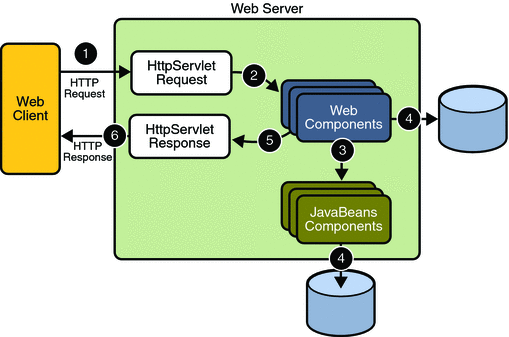Web Applications
In the JavaTM EE platform, web components provide the dynamic extension capabilities for a web server. Web components are either Java servlets, web pages, web service endpoints, or JSP pages. The interaction between a web client and a web application is illustrated in Figure 3–1. The client sends an HTTP request to the web server. A web server that implements Java Servlet and JavaServer PagesTM technology converts the request into an HTTPServletRequest object. This object is delivered to a web component, which can interact with JavaBeans components or a database to generate dynamic content. The web component can then generate an HTTPServletResponse or it can pass the request to another web component. Eventually a web component generates a HTTPServletResponse object. The web server converts this object to an HTTP response and returns it to the client.
Figure 3–1 Java Web Application Request Handling

Servlets are Java programming language classes that dynamically process requests and construct responses. Java technologies, such as JavaServerTM Faces and Facelets, and frameworks are used for building interactive web applications. Although servlets and Java Server Faces and Facelets pages can be used to accomplish similar things, each has its own strengths. Servlets are best suited for service-oriented applications (web service endpoints are implemented as servlets) and the control functions of a presentation-oriented application, such as dispatching requests and handling nontextual data. Java Server Faces and Facelets pages are more appropriate for generating text-based markup, such as XHTML, and are generally used for presentation–oriented applications.
Web components are supported by the services of a runtime platform called a web container. A web container provides services such as request dispatching, security, concurrency, and life-cycle management. It also gives web components access to APIs such as naming, transactions, and email.
Certain aspects of web application behavior can be configured when the application is installed, or deployed, to the web container. The configuration information is maintained in a text file in XML format called a web application deployment descriptor (DD). A DD must conform to the schema described in the Java Servlet Specification.
This chapter gives a brief overview of the activities involved in developing web applications. First it summarizes the web application life cycle. Then it describes how to package and deploy very simple web applications on the Sun GlassFish Enterprise Server. It moves on to configuring web applications and discusses how to specify the most commonly used configuration parameters.
- © 2010, Oracle Corporation and/or its affiliates
